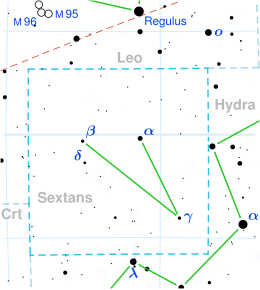HD 93833
| Observation data Epoch J2000.0 Equinox J2000.0 (ICRS) | |
|---|---|
| Constellation | Sextans |
| Right ascension | 10h 49m 43.49171s[1] |
| Declination | −09° 51′ 09.6859″[1] |
| Apparent magnitude (V) | 5.84±0.01[2] |
| Characteristics | |
| Evolutionary stage | horizontal branch[3] |
| Spectral type | K0 III[4] |
| U−B color index | +0.91[5] |
| B−V color index | +1.07[5] |
| Astrometry | |
| Radial velocity (Rv) | 40.3±2.9[6] km/s |
| Proper motion (μ) | RA: +5.882 mas/yr[1] Dec.: −30.041 mas/yr[1] |
| Parallax (π) | 9.4637 ± 0.1343 mas[1] |
| Distance | 345 ± 5 ly (106 ± 1 pc) |
| Absolute magnitude (MV) | +0.76[7] |
| Details | |
| Mass | 1.40[8] M☉ |
| Radius | 10.7±0.5[9] R☉ |
| Luminosity | 60.4±1.0[1] L☉ |
| Surface gravity (log g) | 2.46[10] cgs |
| Temperature | 4,675±22[10] K |
| Metallicity [Fe/H] | −0.11±0.09[11] dex |
| Age | 5.50[8] Gyr |
| Other designations | |
| Database references | |
| SIMBAD | data |
HD 93833 (HR 4233; 73 G. Sextantis) is a solitary star located in the equatorial constellation Sextans. It is faintly visible to the naked eye as an orange-hued point of light with an apparent magnitude of 5.84.[2] Gaia DR2 parallax measurements imply a distance of 345 light-years[1] and it receding with a heliocentric radial velocity of 40.3 km/s.[6] At its current distance, HD 93833's brightness is diminished by an interstellar extinction of 0.18 magnitudes[14] and it has an absolute magnitude of +0.76.[7]
HD 93833 has a stellar classification of K0 III,[4] indicating that it is an evolved K-type giant star that has exhausted hydrogen at its core and left the main sequence. It is currently a red clump star that is on the horizontal branch—fusing helium at its core.[3] It has 1.4 times the mass of the Sun but at the age of 5.5 billion years,[8] it has expanded to 10.7 times the radius of the Sun.[9] It radiates 60.4 times the luminosity of the Sun[1] from its photosphere at an effective temperature of 4,675 K.[10] HD 93833 is slightly metal deficient with an iron abundance of [Fe/H] = −0.11 or 77.6% of the Sun's abundance.[11]
References[edit]
- ^ a b c d e f g Brown, A. G. A.; et al. (Gaia collaboration) (August 2018). "Gaia Data Release 2: Summary of the contents and survey properties". Astronomy & Astrophysics. 616. A1. arXiv:1804.09365. Bibcode:2018A&A...616A...1G. doi:10.1051/0004-6361/201833051. Gaia DR2 record for this source at VizieR.
- ^ a b Høg, E.; Fabricius, C.; Makarov, V. V.; Urban, S.; Corbin, T.; Wycoff, G.; Bastian, U.; Schwekendiek, P.; Wicenec, A. (March 2000). "The Tycho-2 catalogue of the 2.5 million brightest stars". Astronomy and Astrophysics. 355: L27–L30. Bibcode:2000A&A...355L..27H. ISSN 0004-6361. S2CID 17128864.
- ^ a b Laney, C. D.; Joner, M. D.; Pietrzyński, G. (11 November 2011). "A new Large Magellanic Cloud K-band distance from precision measurements of nearby red clump stars". Monthly Notices of the Royal Astronomical Society. 419 (2): 1637–1641. arXiv:1109.4800. Bibcode:2012MNRAS.419.1637L. doi:10.1111/j.1365-2966.2011.19826.x. ISSN 0035-8711. S2CID 117788450.
- ^ a b Houk, Nancy; Swift, Carrie (1999). Michigan catalogue of two-dimensional spectral types for the HD Stars. Vol. 5. Bibcode:1999mctd.book.....H.
- ^ a b Johnson, H. L.; Mitchell, R. I.; Iriarte, B.; Wisniewski, W. Z. (1966). "UBVRIJKL Photometry of the Bright Stars". Communications of the Lunar and Planetary Laboratory. 4: 99–110. Bibcode:1966CoLPL...4...99J.
- ^ a b Gontcharov, G. A. (November 2006). "Pulkovo Compilation of Radial Velocities for 35,495 Hipparcos stars in a common system". Astronomy Letters. 32 (11): 759–771. arXiv:1606.08053. Bibcode:2006AstL...32..759G. doi:10.1134/S1063773706110065. eISSN 1562-6873. ISSN 1063-7737. S2CID 119231169.
- ^ a b Anderson, E.; Francis, Ch. (May 2012). "XHIP: An extended hipparcos compilation". Astronomy Letters. 38 (5): 331–346. arXiv:1108.4971. Bibcode:2012AstL...38..331A. doi:10.1134/S1063773712050015. eISSN 1562-6873. ISSN 1063-7737. S2CID 119257644.
- ^ a b c Dotter, Aaron; Chaboyer, Brian; Jevremović, Darko; Kostov, Veselin; Baron, E.; Ferguson, Jason W. (September 2008). "The Dartmouth Stellar Evolution Database". The Astrophysical Journal Supplement Series. 178 (1): 89–101. arXiv:0804.4473. Bibcode:2008ApJS..178...89D. doi:10.1086/589654. eISSN 1538-4365. ISSN 0067-0049. S2CID 119290835.
- ^ a b Kervella, P.; Thévenin, F.; Di Folco, E.; Ségransan, D. (April 8, 2004). "The angular sizes of dwarf stars and subgiants: Surface brightness relations calibrated by interferometry". Astronomy & Astrophysics. 426 (1): 297–307. arXiv:astro-ph/0404180. Bibcode:2004A&A...426..297K. doi:10.1051/0004-6361:20035930. eISSN 1432-0746. ISSN 0004-6361. S2CID 6077801.
- ^ a b c Luck, R. Earle (25 August 2015). "Abundances in the Local Region. I. G and K Giants". The Astronomical Journal. 150 (3): 88. arXiv:1507.01466. Bibcode:2015AJ....150...88L. doi:10.1088/0004-6256/150/3/88. eISSN 1538-3881. ISSN 0004-6256. S2CID 118505114.
- ^ a b Brown, Jeffery A.; Sneden, Christopher; Lambert, David L.; Dutchover, Edward Jr. (October 1989). "A search for lithium-rich giant stars". The Astrophysical Journal Supplement Series. 71: 293. Bibcode:1989ApJS...71..293B. doi:10.1086/191375. eISSN 1538-4365. ISSN 0067-0049.
- ^ Gould, Benjamin Apthorp (1878). "Uranometria Argentina : brillantez y posicion de las estrellas fijas, hasta la septima magnitud, comprendidas dentro de cien grados del polo austral : con atlas". Resultados del Observatorio Nacional Argentino. 1. Bibcode:1879RNAO....1.....G.
- ^ "HD 93833". SIMBAD. Centre de données astronomiques de Strasbourg. Retrieved January 11, 2024.
- ^ Gontcharov, George A.; Mosenkov, Aleksandr V. (28 September 2017). "Verifying reddening and extinction for Gaia DR1 TGAS main sequence stars". Monthly Notices of the Royal Astronomical Society. 472 (4): 3805–3820. arXiv:1709.01160. Bibcode:2017MNRAS.472.3805G. doi:10.1093/mnras/stx2219. eISSN 1365-2966. ISSN 0035-8711. S2CID 118879856.

